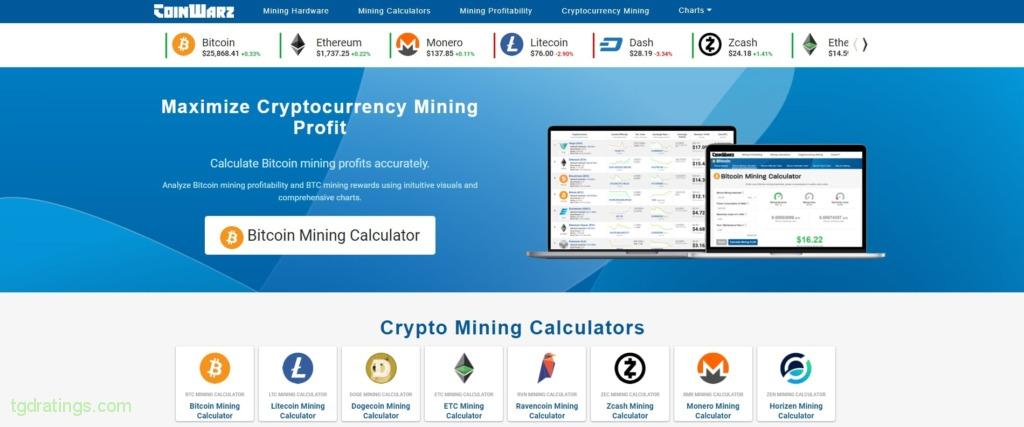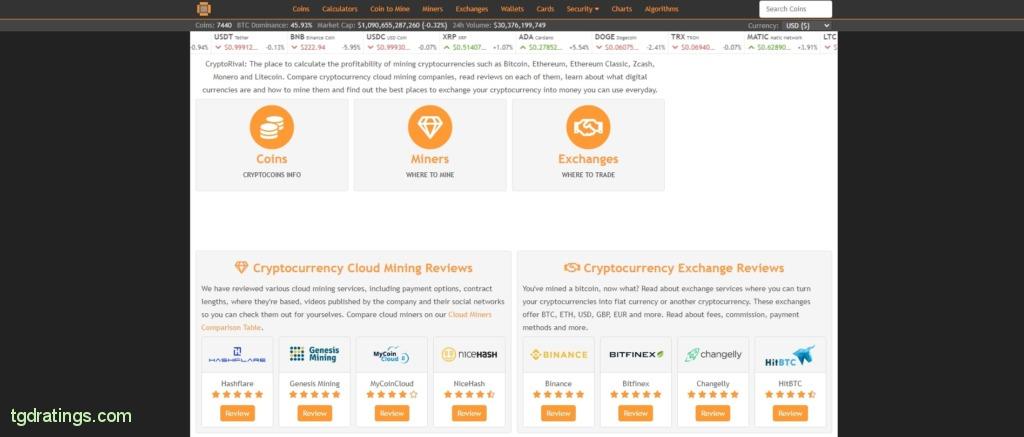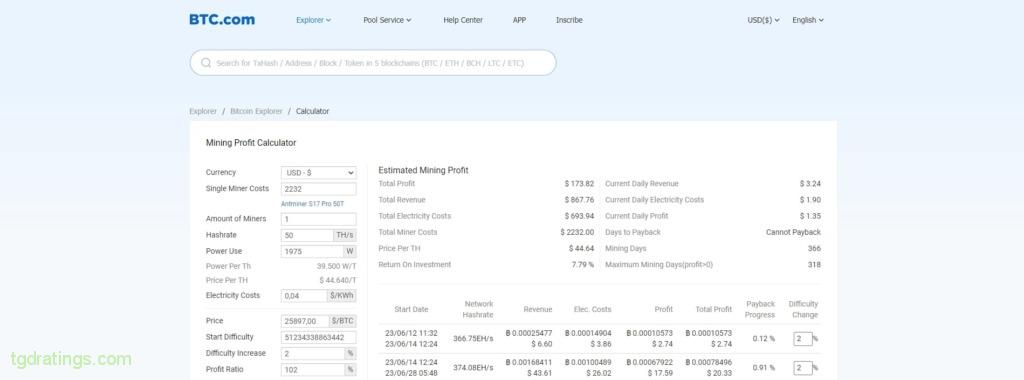Best Mining Calculators Overview for 2025
Mining calculators help you calculate the profit you can get from mining Bitcoin or altcoins. Such services are convenient to use at the stage of assembly of a mining setup, equipment updating or assessing the profitability of mining a particular coin. I used different calculators and compiled top 10 best services that will help calculate mining profitability for both beginners and professionals.
Main types of mining profitability calculators
There is no generally accepted classification of mining calculators, but they can be conditionally divided into 2 groups:
- Simple and complex. Simple calculators allow you to calculate the profitability without taking into account the equipment that is used for mining. In complex calculators, the user can enter the quantity and models of equipment, electricity cost, to take into account the level of network hashrate, pools fees, etc. These ones allow making more detailed calculation;
- Specialized and built-in. Specialized calculators are the separate services with wide functionality and the possibility of complex calculations. Built-in ones – most often are the part of platforms with other functionality (miners sites, pools or cloud mining companies, etc.). Such services can calculate only basic data (for example, the return on a coin within a month with a specified hashrate).
Top 10 cryptocurrency mining calculators for 2025
This calculators top includes specialized platforms with wide functionality, as well as simple services that can only provide general information. Let’s take a closer look at each of the calculators.
1. WhatToMine
Address: https://whattomine.com/

WhatToMine is one of the most popular and detailed mining calculators. It can calculate mining profitability for ASICs and GPUs. The service allows you to customize the initial data for calculations, down to the cost of equipment, power consumption and network complexity. WhatToMine supports a large number of coins relevant for mining and gives a wide list of calculation results: for the near future (hour, day), for the future (week, month) and historical data results.
- Service type: specialized;
- Number of coins: 130+ (BTG, ETHW, ETC, GRIN, LTC, RVN, VTC, NEOX, etc.);
- Supported devices: ASIC, GPU;
- Additional features: a list of the best video cards and ASICs by hashrate, merged mining profitability calculations.
Pros and cons
2. Hashrate.no
Address: https://hashrate.no/

Hashrate.no is one of the few calculators that allows you to calculate mining yield for CPU and FPGA in addition to ASIC and GPU. It has a user-friendly interface and extensive statistics on equipment efficiency for each coin. The list of settings is minimized, but you can set, for example, the number of devices, their models, the cost of electricity and setup, or use the calculation using the total setup hashrate. Based on the results of calculations, the service issues income and profit for the next day/month and historical data.
- Service type: specialized;
- Number of coins: 60+ (BTC, BTG, CLO, ETHW, ETC, GRIN, LTC, RVN, VTC, etc.);
- Supported devices: ASIC, GPU, CPU, FPGA;
- Additional features: guides and articles on mining topics, a list of proven software and mining pools, a separate calculator for calculating the profitability of GPU mining.
Pros and cons
3. NiceHash
Address: https://www.nicehash.com/profitability-calculator

A simple calculator from the developers of the NiceHash software miner. It allows you to quickly calculate the profitability of a setup of ASICs, GPUs and CPUs. It is possible to distribute the hashrate of the specified equipment among various mining algorithms (enabled in advanced settings), compare different setups, take into account the cost of electricity and get the calculation in some national currencies (for example, USD, CNY, GBP, etc.). Returns average income per day and historical data as a result.
- Service type: built-in;
- Number of coins: it is not possible to select a coin – the calculation can be carried out either by choosing equipment or by distributing the hashrate according to the required mining algorithms;
- Supported devices: ASIC, GPU, CPU;
- Additional features: autodetection of the current mining setup and calculation based on it.
Pros and cons
4. CoinWarz
Address: https://www.coinwarz.com/

CoinWarz allows user to calculate the yield for 200+ coins. It is impossible to select devices for calculating profitability – you must specify the hashrate manually. But there are some additional calculation parameters one can use: energy consumption, electricity price, setup cost, pool fees, network complexity and block reward. The results show coin yield per mining hour and in-coin and USD yield per day.
- Service type: specialized;
- Number of coins: 200+ (BTC, BCH, LTC, RVN, ZEC, XMR, ZEN, BEAM, etc.);
- Supported devices: no, calculation is carried out based on the size of common hashrate;
- Additional features: Separate network difficulty and hashrate charts.
Pros and cons
5. Minerstat
Address: https://minerstat.com/mining-calculator

This is a calculator from the Minerstat platform, which develops mining software. The service allows you to calculate mining profitability for GPUs and ASICs. It is possible to add custom devices. Among additional calculation parameters there are: setup energy consumption, electricity price, pool fees. The results on
profitability of coins by periods can be switched in a wide range (from 3 hours to 3 days). It is also possible to display results in national currencies.
- Service type: built-in;
- Number of coins: 120+ (BTC, ETHW, ETC, BCH, DOGE, RVN, ZEC, ZEN, LOKI, etc.);
- Supported devices: ASIC, GPU, it is possible to add a custom device by specifying a hashrate;
- Additional features: the option to add setup builds (registration required), the lists of GPUs and ASICs with the highest coin yield.
Pros and cons
6. CryptoRival
Address: https://cryptorival.com/calcs/

CryptoRival analytical platform calculator allows you to calculate the profitability by specifying the setup hashrate. One can use these calculating parameters: energy consumption, electricity price, pool fees, equipment or contract cost (for cloud mining), network difficulty, block reward. As the result of calculation the use get a data on the profitability of coin mining per day, week, month and year.
- Service type: built-in;
- Number of coins: 110+ (BTC, ETHW, ETC, BCH, DOGE, RVN, ZEC, ZEN, LOKI, etc.);
- Supported devices: no, calculation is carried out based on the size of common hashrate;
- Additional features: Minicalculator for BTC mining profitability.
Pros and cons
7. 2CryptoCalc
Address: https://2cryptocalc.com/

2CryptoCalc is a simple calculator that allows you to calculate the yield on the most popular coins for mining. User can make calculations based on two models: by hardware type and by setting the hashrate. At the same time, you can only adjust either the amount of equipment (on the main page) or the hashrate (on the coin page) – the rest of the data is substituted automatically. The results are presented as yield per hour, day, week and month.
- Service type: specialized;
- Number of coins: 18+ (ETC, ETHW, ZEN, ZEC, XMR, BTG, RVN, KAS, BIM, ERG, etc.);
- Supported devices: ASIC, GPU, hashrate calculation;
- Additional features: Lists of GPUs and ASICs with the highest coin returns.
Pros and cons
8. BTC.com
Address: https://pool.btc.com/

BTC.com pool mining calculator. Allows you to make a detailed BTC profitability calculation and provides a list of the best ASIC miners to mine 7 coins. In the calculator settings for BTC, you can choose: calculation currency, equipment cost (only what the pool uses is offered), electricity cost, power consumption, difficulty, difficulty growth percentage, pool profitability percentage, period of participation in the pool. In the simple list of miners there is only setting: electricity cost consumed per day. The result shows yield for each day in BTC and USD.
- Service type: build-in;
- Number of coins: 7 (BTC, BCH, LTC, GRIN, ETC, ZEC, DASH, DCR);
- Supported devices: For calculations with BTC, the service uses only the miner with which the pool works, but you can specify their number. For the rest of the coins there is only a list of effective ASIC miners is presented;
- Additional features: detailed BTC profitability statistics.
To go to the BTC calculator page:
- Click Explorer in the upper left corner of the main page of service, select a coin and click on its name;
- On the next page click Explorer again and select Calculator from the drop-down list.
Pros and cons
9. CryptoCompare
Address: https://www.cryptocompare.com/mining/calculator/

Crypto Compare service is a calculator by CCDATA. It allows you to calculate the mining profitability for 6 cryptocurrencies. One can use such input information: hashrate, electricity cost, pool fees and power consumption. The results of the profitability calculation are provided per day, week, month, year format in USD.
- Service type: built-in;
- Number of coins: 6 coins – BTC, ETC, XMR, ZEC, DASH, LTC;
- Supported devices: no, calculation is carried out based on the size of common hashrate;;
- Additional features: none.
To go to the calculator page:
- Activate the Markets tab on the top menu of the main page, select Top Lists;
- Select Mining Calculator from the drop-down list.
Pros and cons
10. Asicminervalue
Address: https://www.asicminervalue.com/

Asicminervalue is a simple service for reviewing the profitability of ASIC miners. Works in Efficiency and Yield modes (switchable in the Miners top menu). The service indicates the profitability of ASIC miners depending on the mining algorithm, and also shows the the most profitable algorithm for mining depending on the miner used. From the available settings – an option to specify the electricity cost.
- Service type: specialized;
- Number of coins: none;
- Supported devices: ASIC;
- Additional features: efficiency and profitability modes.
Pros and cons
Factors affecting the profitability of crypto mining
The profitability of mining is influenced by many factors, including: equipment hashrate, cost per kilowatt of electricity, equipment energy consumption and number of mining devices, current blockchain difficulty, block reward, price of cryptocurrency in the market, pool fees etc. Let’s consider some parameters in more detail.
Hashrate
Hashrate (the term “computing power” is also used) is the number of calculations that equipment can perform per unit of time or the speed of solving a cryptographic puzzle. Most often it measured in Eh/s, Th/s and Gh/s – Exa- (10 to the 18th power), Tera- (10 to the 12th power), Giga- (10 to the 9th power) hashes per second, respectively. The higher the hashrate of the equipment, the more likely the miner will solve the cryptographic puzzle first and receive a reward. The average computing power of the equipment is presented in mining calculators. The hashrate can be increased using various optimization techniques (“overclocking”).
Electricity cost
The cost of electricity directly affects the cost of mining. The more expensive is a kilowatt of electricity, the less the miner will earn. You can reduce your electricity bills by equipment energy optimization.
Energy consumption
It is determined by the number of devices and their level of electricity consumption. The level of consumption is set by the power of the equipment, which is measured in Watts (the amount of energy consumed per unit of time). The more devices miner has and the higher their power consumption, the higher its costs. Power consumption can be reduced by purchasing new and less energy-intensive equipment, replacing energy-intensive parts of equipment with more economical ones, optimizing at the software level, and so on.
Mining setup
A setup refers to the number, quality and types of devices that are used for mining (CPU, GPU, ASIC, etc.). Often, the concept of a setup also includes additional devices: holders, switches, cooling systems, etc. As a rule, the more modern and “fresh” equipment is used, the better the setup. Also, when assembling a setup, its proper optimization at the hardware and software levels is important.
Network complexity
Network complexity is a number that shows how many times on average you need to calculate a hash (solve a cryptographic puzzle) to find a block (get a reward). Many blockchains use the concept of average block formation time, for example, in BTC it is about 10 minutes. The complexity of the network is needed in order to regulate the overall value of the blockchain hashrate and keep the required block interval constant. If the total value of computing power in the blockchain (its hashrate) grows, then the complexity also grows. If the blockchain hash rate goes down, the complexity goes down too. The higher the complexity of the network, the less often an individual miner (while keeping its hash rate constant) will find a new block.
Block reward
The block reward determines how many coins a miner will receive when he correctly solves a cryptographic puzzle and gets the right to write a new block into the blockchain. Usually the block reward is fixed at a certain level for some period and decreases according to a predetermined schedule (halving dates). That is why miners are looking for new coins that support the PoW algorithm – in the first years of their existence, the reward in such blockchains is higher than in subsequent ones. The higher the block reward, the higher the miner’s earnings.
Cryptocurrency prices
The current prices for cryptocurrency significantly affect the income of the miner. A decrease in the price of an asset in the market may reduces the profitability from mining in dollar terms to the point that mining a coin becomes unprofitable. Professional miners always keep track of the current market prices of the coins they mine. The higher the price of the coin, the the higher the income of the miner.
Pool fees
Many cryptocurrencies are most profitable to mine in pools. Due to the high hashrates of the pools, a miner can provide a constant (albeit slightly lower than with solo mining) income from mining coins. At the same time, most of the pools charge commissions. The average fee is around 2%, but depending on the coin and how the rewards are calculated, it can be as high as 5% or more. The more profitable for the pool side the methodology for calculating remuneration is applied, the lower its commission can be. And at the same time, the lower the pool fee, the higher the miner’s income.
Methods of calculating payouts in pools
Pools calculate payouts to miners for the found block in different ways. In total, there are about 20 payment calculation methods. There are two main differences between these methods:
- How the reward is distributed when the pool does not find new blocks for some time;
- Whether the pool shares with the miner fees for the transactions that were written to the found block.
The following payment calculation methods are most commonly used:
- PPS – the pool always pays, but does not share commissions;
- PPS+ – the pool always pays and shares fees when a block is found;
- FPPS – the pool always pays, but only shares the average fees in the blockchain (not actual ones);
- PPLNS – the pool only pays when a block is found and does not share commissions.
The choice of calculation method can increase or decrease the income of the miner, depending on the market situation, complexity and the total network hashrate. Usually the pools use PPS or PPS+ methods.
Software miner fees
To connect to the pools, you will need special software – miners. Sometimes ASIC miners or a crypto project team can provide free software to work with pools, but more often you will have to download and install a special program. Developers of such programs may charge fees for their use. Most often, it is up to 1-2% of the yield in the pool. Obviously, the lower the commission, the higher the income of the miner.
FAQ
- Go to the mining profitability calculator, for example, on whattomine.com;
- Select a coin to mine;
- Enter the amount of equipment, its type and other data into the calculator (most often it will be enough to specify the hashrate, setup power, pool commission and electricity cost);
- Calculate yield.
- Go to the mining profitability calculator, for example, on Coinwarz;
- Select BTC as mining coin;
- Enter the amount of equipment, its type and other data into the calculator (most often it will be enough to specify the hashrate, setup power, pool commission and electricity cost);
- Calculate mining profitability.
Conclusions
Profitability calculators help miners to calculate the profit from mining a particular cryptocurrency. Such services can be divided into simple and complex, specialized and built-in. Depending on the type of calculator, its functions will differ. In complex and specialized services, the results are more accurate due to the large amount of data that is taken into account in the calculations. It is convenient to use mining calculators at the stage of assembling a mining setup, equipment updating or to determine the profitability of mining a particular cryptocurrency.










